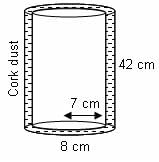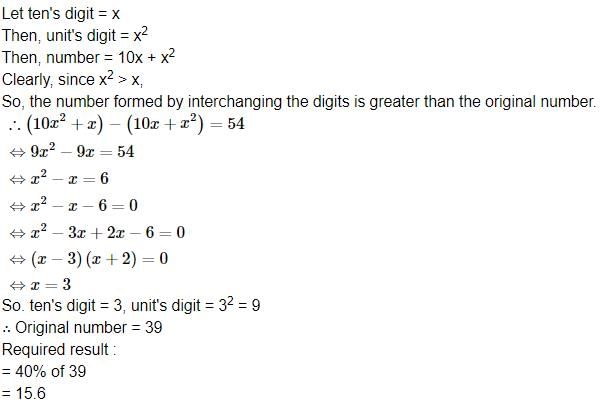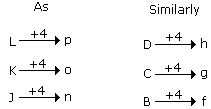SSC MTS Mock Test - 7 - SSC MTS / SSC GD MCQ
30 Questions MCQ Test - SSC MTS Mock Test - 7
Study the following line graph and answer the questins.
Exports from Three Companies Over the Years (in Rs. crore)

Q. Average annual exports during the given period for Company Y is approximately what percent of the average annual exports for Company Z?
Exports from Three Companies Over the Years (in Rs. crore)

Q. Average annual exports during the given period for Company Y is approximately what percent of the average annual exports for Company Z?
The average of eight numbers is 25, that of the first two is 20 and of the next three is 26. The sixth number is less than the seventh by 4, and less than the eighth by 6. The last number is
Three years ago , the average age of a family of 5 members was 17 years. Inspite of the birth of a child in the family, the present average age of the family remains the same. The present age of the child is
What is the difference between the simple interest on a principal of Rs. 500 being calculated at 5% per annum for 3 years and 4% per annum for 4 years?
In a two digit positive number, the digit at the units place is equal to the square of the digit in ten’s place and the difference between the number and the number obtained by interchanging the digits is 54. What is 40% of the original number?
Find the 4-digit smallest number which when divided by 12, 15, 25, 30 leaves no remainder?
12 percent of the voters in an election did not cast their votes. In this election there are only two candidates. The winner by obtaining 45% of the total votes and defeated his rival by 2000 votes. The total number of votes in the election
Set A contains 10 consecutive numbers starting from x and set B contains 8 consecutive even numbers starting from y. The ratio of the average of set A elements to that of set B elements is 9 : 14. What is the ratio of x to y?
A cylindrical vessel of diameter 14 cm and height 42 cm is fixed symmetrically inside a similar vessel of diameter 16 cm and height 42 cm. If the total space between the two vessels is filled with cork dust for heat insulation purposes, then how many cubic centimetres of cork dust will be required?

A tap drips at an average rate of 2 drops in 3 seconds. It takes 2080 drops of water to completely fill a hemispherical vessel of radius 8.3 cm. How many times can the vessel be filled in this manner in 13 hours?
Read the passage below and solve the questions based on it.
1. In a joint family of seven persons A, B, C, D, E, F and G, there are two married couples.
2. G is a housewife and her husband is a lawyer. ‘C’ is the wife of ‘B’, ‘A’ is an engineer and is granddaughter of ‘G’. ‘D’ is the father-in-law of ‘C’, a doctor, and father of ‘E’, a Professor. ‘F’ is A’s brother and B’s son.
Who is a lawyer?
In this following question, four words have been given, out of which three are alike in some manner and the fourth one is different. Choose out the odd one out.
Directions to Solve
In each of the following questions find out the alternative which will replace the question mark.
Question -
Corden : zrogbq :: ? : pxivro
Directions to Solve
In each of the following questions find out the alternative which will replace the question mark.
Question -
LKJ : pon :: ? : hgf
Direction : Study the following question carefully and choose the right answer.
Q: If ‘COUNSEL’ is to ‘BITIRAK’ so also ‘GUIDANCE’ is to
During whose Governor Generalship the Maratha confederacy ended?
The site of birth [nativityl of Gautam Buddha is marked by oy:
What is the significance of the India-Japan Memorandum of Cooperation (MoC) for the development of the Integrated Mast?
Praise for Johnny Starstruck and his entourage are common, although statisticsshow Americans still associate his name with the ritualistic murders.
Direction: Each question below has one blank, which is indicating that something has been omitted. Find out which option can be used to fill up the blank in the sentence in the same sequence to make it meaningfully complete.
Buying a home is one of the most _____________ financial decisions we need to take.
Directions: Read the passage and answer the questions that follow:
Development is about expanding the capabilities of the disadvantaged, thereby improving their overall quality of life. Based on this understanding, Maharashtra, one of India’s richest States, is a classic case of a lack of development which is seen in its unacceptably high level of malnutrition among children in the tribal belts. While the State’s per capita income has doubled since 2004, its nutritional status has not made commensurate progress.
Poor nutrition security disproportionately affects the poorest segment of the population. According to NFHS 2015-16, every second tribal child suffers from growth restricting malnutrition due to chronic hunger. In 2005, child malnutrition claimed as many as 718 lives in Maharashtra’s Palghar district alone. Even after a decade of double digit economic growth (2004-05 to 2014-15), Palghar’s malnutrition status has barely improved.
In September 2016, the National Human Rights Commission issued notice to the Maharashtra government over reports of 600 children dying due to malnutrition in Palghar. The government responded, promising to properly implement schemes such as Jaccha Baccha and Integrated Child Development Services to check malnutrition. Our independent survey conducted in Vikramgad block of the district last year found that 57%, 21% and 53% of children in this block were stunted, wasted and underweight, respectively; 27% were severely stunted. Our data challenges what Maharashtra’s Women and Child Development Minister said in the Legislative Council in March — that “malnutrition in Palghar had come down in the past few months, owing to various interventions made by the government.”
Stunting is caused by an insufficient intake of macro- and micro-nutrients. It is generally accepted that recovery from growth retardation after two years is only possible if the affected child is put on a diet that is adequate in nutrient requirements. A critical aspect of nutrient adequacy is diet diversity, calculated by different groupings of foods consumed with the reference period ranging from one to 15 days. We calculated a 24-hour dietary diversity score by counting the number of food groups the child received in the last 24 hours. The eight food groups include: cereals, roots and tubers; legumes and nuts; dairy products; flesh foods; eggs; fish; dark green leafy vegetables; and other fruits and vegetables.
In most households it was rice and dal which was cooked most often and eaten thrice a day. These were even served at teatime to the children if they felt hungry. There was no milk, milk product or fruit in their daily diets. Even the adults drank black tea as milk was unaffordable. Only 17% of the children achieved a minimum level of diet diversity — they received four or more of the eight food groups. This low dietary diversity is a proxy indicator for the household’s food security too as the children ate the same food cooked for adult members.
Q. Which of the following is/are true as per the passage?
I. India’s situation is worse than in some of the world’s poorest countries — Bangladesh, Afghanistan or Mozambique.
II. Development is more than just economic growth.
III. On an average, the nutrition expenditure as a percentage of the Budget has drastically declined from 1.68% in 2012-13 to 0.94% in 2018-19.
Directions: Out of the given alternatives, choose the one which can be substituted for the given words/sentence.
A person who is womanish in his habits






















